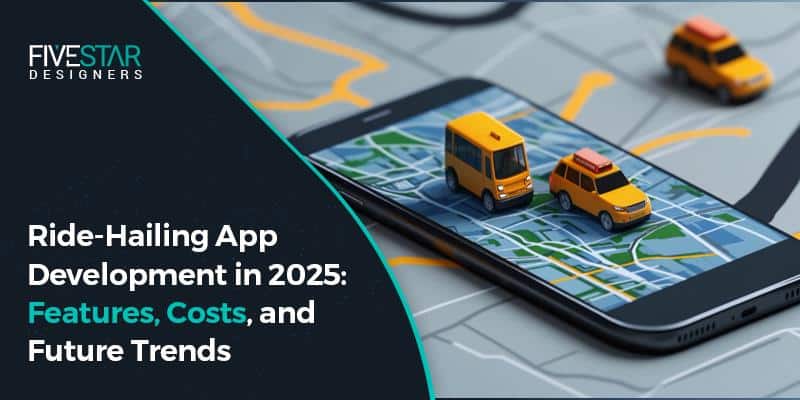Modern transportation has evolved with the help of Ride-Hailing Apps, from Uber to numerous local startups redefining city mobility. This concept is simple: tap a button, get a ride; however, developing a successful ride-hailing app is far from simple.
From GPS tracking and digital payments to AI-driven safety features, Ride-Hailing App Development offers huge potential for startups and businesses and also adds value to riders and drivers.
Why Ride-Hailing Apps Are Growing in 2025?
It is stated that the global taxi and ride-hailing market is expected to reach USD 287.6 billion by 2034, up from USD 74.9 billion in 2024. The tech revolution, sustainability, and evolving user behaviour are fueling this growth. Here are some of the key reasons:
- For your daily commuting, it has now become easier to book a ride, faster, cheaper, and more reliable.
- In this evolving era, owning a car is quite costly, so ride-sharing apps make city life easier.
- To ensure safe and smooth rides, features like GPS and live tracking systems are available.
- Government pushes eco-friendly transport for EV taxis and greener fleets.
- Customer demands are flexible, ranging from short trips to airport rides and various user demand options.
In short, ride-hailing app development in 2025 is driven by convenience, cost efficiency, and sustainability; these 3 pillars are reshaping travel worldwide.
Must-Have Features in a Ride-Hailing App
Every Ride-Hailing App must deliver performance, safety, and user satisfaction to compete in 2025.
Riders-Side Features:
- With innovative request rides, find the nearest drivers instantly.
- Get real-time updates on divers’ whereabouts and route with live GPS tracking.
- Estimate your fair amounts before confirming the rides.
- Build trust and improve driver quality with the help of reviews and ratings.
Driver-Side Features:
- With the feature of request and accept, you can easily manage incoming rides.
- AI-powered navigation also aids in finding smart routes and predicting traffic.
- Track your income and performance through earning dashboards.
- Control your status whether to stay online or offline.
- Improve your service quality with the help of user feedback access.
Safety and Support:
- With the SOS emergency button feature, alerts support or authorities in real-time.
- Send your ride progress to trusted contacts.
- Verify driver ID and documents through the app’s verification feature.
Admin Dashboard:
- The feature auto dispatch and matching system efficiently assigns rides.
- Track performance, demand, and user behaviour through advanced analytics.
- An AI fraud detector prevents fake rides and spam accounts.
All these features make a Ride-Hailing App competitive, secure, advanced, and user-friendly, essential for success in 2025.
Cost of Ride-Hailing App In 2025
The costs of building a ride-hailing app vary depending on factors such as complexity, sustainability, design, and development. Here is an estimated version based on 2024-2025 industry data:
App Type | Features | Estimated Cost (USD) | Timeline |
Basic / MVP Taxi App | Booking, GPS tracking, and payments | $100,000 – $200,000 Approx. | 6–12 months |
Mid-Level App | Chat, scheduling, analytics, custom UI | $200,000-500,000 Approx. | 6- 12 months |
Full Uber-Like Solution | AI, EV/AV integration, surge pricing | $500,000-1,000,000+ Approx. | 8–12+ months |
Main Cost Factor:
- App Platform: iOS, Android, or Cross-platform (Flutter, React Native).
- Development Team Location: US costs, Asia and Eastern Europe.
- Third-Party APIs: Maps, payments, SMS, and Cloud Storage.
- Backend Architecture: Secure servers, scalability, maintenance, and analytics tools.
- Design Quality: A clean UX/UI increases retention and trust.
When hiring a ride-hailing app development company, choose one with proven experience in mobility software and live tracking systems, as this ensures scalability and a seamless user experience.
Latest Trends: EVs, AI and Autonomous Taxis
Electric Vehicle (EV) Taxi Apps:
In 2025, more companies are integrating EV route optimisation, charging station locators, and “Green Ride” options for eco-conscious users.
Autonomous Ride-Hailing:
Autonomous taxis have gone beyond a science fiction concept, and companies like Waymo, Uber, and Cruise are testing these AI-driven taxis in the US. More features like autonomous navigation, sensor data, security, and vehicle-to-app communication should be added in future ride-hailing app development.
AI in Ride Sharing Apps:
AI powers smarter ride-matching, predictive pricing, and fraud prevention. AI also enables voice-based support and real-time route optimisation, reducing waiting times and fuel costs.
Super App Evolution:
Platforms like Grab and Gojek are merging ride-hailing, food delivery, and digital payments, a strategy that boosts engagement and user retention.
Smart City Integration:
Apps now connect with city traffic systems, public transport APIs and smart parking, enabling smooth travel and efficient traffic flow.
Challenges in Ride-Hailing App Development
While 2025 is an era of opportunities, challenges don’t hold back:
- Regulatory Restrictions and the Gig Worker Law.
- Thin profit margins due to high competition.
- Driver shortages and rising fuel costs.
- Data privacy and cybersecurity compliance.
- Economic instability in a developing market.
The Future of Ride-Hailing Apps
Moving forward with the future of ride-hailing app development is a smart, automated, eco-friendly, and sustainable approach, as the ride-hailing app industry is reinventing itself with every technological leap.
Features like robotaxis going mainstream in major US cities, EVs dominating rides, reducing carbon footprints, personalised rides remembering user preferences, integrated mobility, subscription models, and an AI-powered management system for dispatch, pricing, and support are fueling the ride-hailing industry.
Conclusion
In 2025, building a successful ride-hailing app goes beyond coding; it’s more about fostering user trust, delivering a smooth user experience, ensuring long-term scalability, and promoting sustainability.
If your business is planning to launch a ride-hailing app, start with a clear roadmap, a realistic taxi app development cost, and a trusted technology partner. 5 Star Designers specialise in ride-hailing app development, taxi applications, and ride-sharing platforms.
FAQs
- How long did it take to develop a ride-hailing app like Uber?
Development typically takes 6to12 months, depending on features, app design, infrastructure, and team expertise. Complex apps with AI or EV integration can take longer.
- Which technologies are the best for ride-hailing app development in 2025?
Popular tech stacks may include Flutter and react native for cross-platform apps, Node.js or Python for backend, and Google Maps API or Mapbox for location tracking.
- How can I make my ride-hailing app stand out in a competitive market?
Focus should be on user experience, safety, and AI-powered personlaized. Adding features like EV ride options, real-time support, and subscription-based loyalty programs can also set your app apart.



